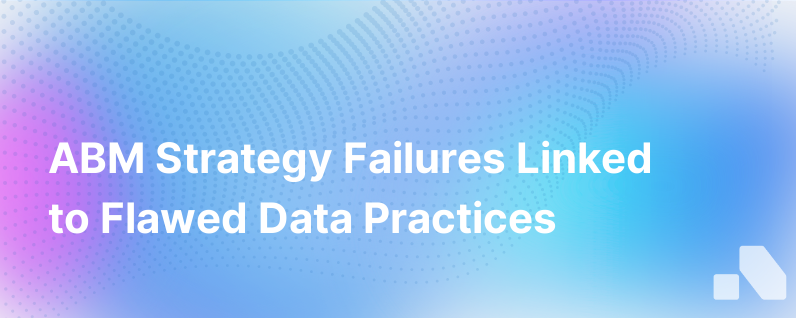Abm Strategy Falling Short Blame Your Data
Published on September 24, 2023 by David Zhang
In the data-driven world of B2B marketing, Account-Based Marketing (ABM) represents a paradigm shift from traditional lead-centric strategies to a focus on targeted groups of key accounts. ABM's premise is straightforward—identify high-value accounts, tailor your marketing efforts toward these, and synchronize marketing and sales like never before. However, even the most intricately designed ABM campaigns are susceptible to failures that are often rooted in one critical element: data.
Unveiling the ABM Strategy
Before we delve deeper into where things can fall apart, let's briefly review what constitutes an ABM strategy. ABM turns the traditional marketing funnel on its head. Instead of casting a wide net to capture as many leads as possible, it selects a few 'big fish' companies as primary targets. This flip requires incredibly refined, specific, and detailed approaches, all of which should be supported by the richest data you can muster.
The ABM approach involves several steps, from identifying and selecting key accounts to delivering personalized campaigns, aligning marketing and sales, and measuring the strategy's effectiveness. Each step needs a data-backed rationale to ensure its success.
The Achilles' Heel of ABM: Flawed Data
Now, let's get to the heart of the issue—why does data make or break your ABM efforts? Simply put, an ABM strategy is only as good as the data underpinning it. Data supports all aspects of ABM, from identifying the correct accounts to engage with, to understanding their needs, personalizing the outreach, and finally, enabling you to measure performance and ROI.
So, what happens when the data is lacking?
- Inaccurate Targeting: Faulty data leads to poorly defined Ideal Customer Profiles (ICPs) and account selection, making your precise targeting approach more akin to shooting in the dark.
- Misaligned Messaging: With bad data, even the most creative and persuasive marketing campaigns misfire because they're based on incorrect insights. Communication with prospects needs to be on-point and relevant to make an impact.
- Sales and Marketing Misalignment: The basis of ABM's success is its orchestrated approach between marketing and sales. When data is amiss, these teams can't align on the right targets or strategies, leading to wasted efforts and opportunities.
- Poor Customer Experiences: Your prospects expect personalized experiences, and that requires you to truly know them. Inaccurate data can lead you to make erroneous assumptions that sour your brand's reputation.
Factors Leading to Poor Data Quality
Data can suffer in quality for a plethora of reasons. At the top of that list are:
- Incomplete Data: This occurs when vital information is missing, such as contact details or firmographic data, rendering your account intelligence insufficient.
- Out-of-Date Data: B2B contact data is known for depreciating rapidly. If your data isn't continually refreshed, you'll fall behind as contacts move jobs or companies evolve.
- Inaccurate Data: Even small inaccuracies can set off troublesome domino effects, leading your well-conceived campaigns to go astray.
- Data Silos: When data exists in different parts of an organization without a way to synthesize, it’s easy to lose out on a cohesive view—and, thus, appropriate action.
Evaluating the Data Skeleton of Your ABM Strategy
Here's how you can assess and address the data shortfalls in your ABM framework:
- Assess Your Sources: Are you pulling data from reliable, reputable sources? Ensure the data you use is high-quality to start with.
- Implement Continuous Data Hygiene: Regularly clean your data to remove duplicates, correct inaccuracies, and fill in gaps. This process is essential to keep your data relevant and actionable.
- Embrace a Data Culture: Champion the importance of data across sales and marketing. Every team member should understand the role data plays and maintain its integrity.
- Leverage Technology: Tools and platforms like AI-driven data enhancement can help keep your databases up-to-date without heavy lifting from your team.
- Opt for Real-time Data: Using solutions that provide real-time data insights can give your ABM campaigns a competitive edge.
- Integrate Your Data: Break down silos by integrating your CRM, marketing automation, and other data systems for a single, unified view of your accounts.
The Path Forward: Data as the ABM North Star
To correct a faltering ABM strategy, businesses must prioritize the revamping of their data ecosystem. Taken seriously, such a foundational fix can transform the effectiveness of your ABM approach.
Remember, good data allows you to:
- Understand each account's specific needs and opportunities.
- Engage with them in a meaningful, personalized way.
- Monitor, analyze, and optimize your efforts effectively.
Conclusion
The path to ABM success is clear: without reliable data, your strategy is fundamentally undermined. Focusing on fostering a robust data foundation isn't just nice-to-have; it is pivotal.
In the B2B marketplace, with its long sales cycles and complex buying processes, a data-centric approach to ABM is non-negotiable. As initiatives pivot more towards quality over quantity and relationships over transactions, the spotlight on accurate, accessible, and actionable data only brightens.
If you are re-evaluating your ABM framework, or starting out fresh, by enforcing a robust, dynamic data backbone, you set the stage for a strategy that's resilient, responsive, and, most importantly, revenue-generating. And if you're looking for a partner to facilitate this, platforms like Aomni can help to ensure your data is evergreen—fueling an ABM strategy primed for success.